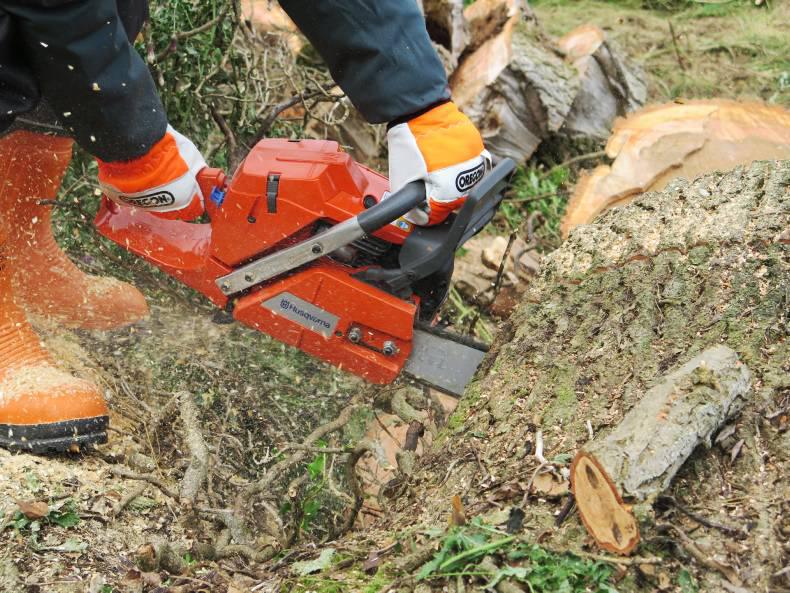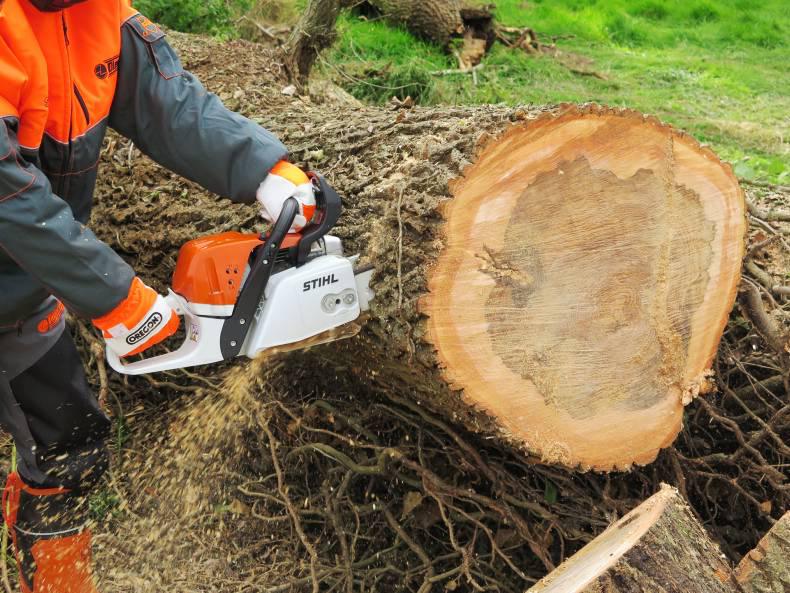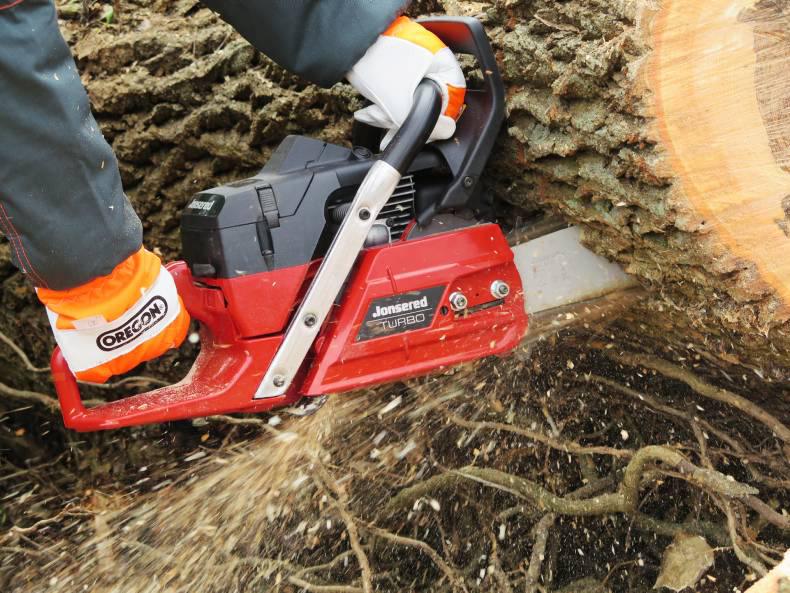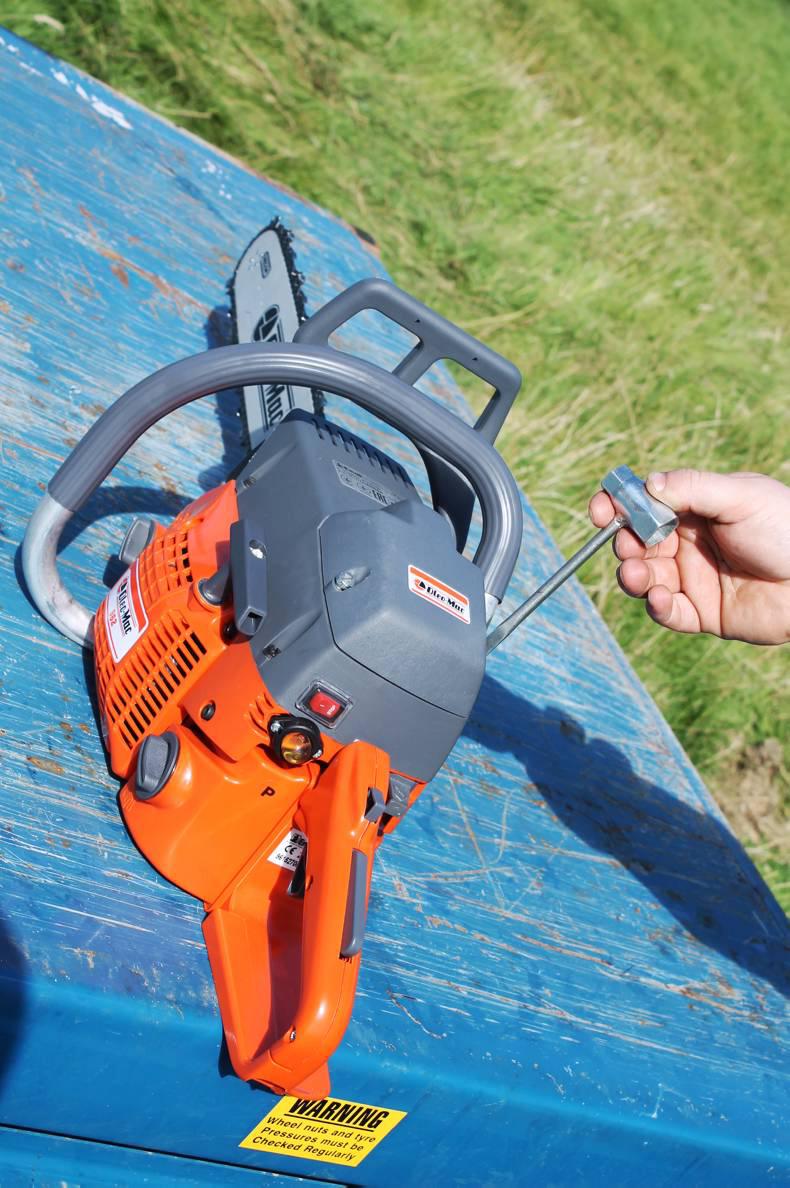Chainsaws come in three categories – hobby, semi-professional and professional. Pricing is generally structured in much the same way, with hobby chainsaws being the cheapest and professional chainsaws naturally being the most expensive.
The brands tested were Stihl (Germany), Husqvarna (Sweden), Oleo-Mac (Italy), Jonsered (Sweden) and McCulloch (Sweden).
Most popular in the agricultural sector are semi-professional chainsaws, which made up the larger element of this group test.
A typical saw in this category will be around 60cc to 65cc, 4hp to 5hp and fitted with a 20in bar. This provides the user with loads of power to tackle the odd fallen tree or even fell a tree, while also being not too cumbersome for smaller jobs and fencing.
We also had a peek at the hobby and professional sectors because there will always be customers for both in agriculture. Farmers with a bigger budget may often have a smaller and lighter hobby-spec machine for bowing, fencing and general use. Professional chainsaws are geared towards those doing a lot of saw work or even engaged in forestry, as well as farming.
Test
Our three semi-professional saws for testing were the Stihl MS391, Husqvarna 365 and Oleo-Mac CS650. The two professional saws in the group test were the Jonsered CS2166 and Oleo-Mac 962. Nipping at the heels of them all was the hobby-spec McCulloch CS450 Elite.
To assess the semi-professional saws on equal terms, we requested they be 65cc (+/- 5cc) and fitted with a 20in bar. All of the larger saws were fitted with a 20in bar and 3/8in pitch chain. The hobby McCulloch had an 18in bar and 0.325in pitch chain.
We looked at how easy each machine was to maintain, including re-fuelling and oiling, access to the air filter for cleaning and spark plug, chain and bar adjustment and if the chain oiler was adjustable.
All saws featured spiked grippers, which help the operator when cutting large-diameter trees. This reduces the usable length of the bar slightly, so we measured this as part of our test. This measurement was taken along the centre line of the bar, from the front of the gripper spikes to the outside of a cutter at the nose of the bar.
The final measurement we took was of the actual chainsaw weight or operational weight. This was the weight of the chainsaw fitted with a 20in bar and chain (McCulloch 18in), plus full with fuel and chainsaw chain oil. Manufacturers tend to quote a dry saw weight without bar and chain.
The tree used for this test was a very large ash tree that was blown down some months back in a storm. It provided limbs and branches of all sizes, plus a large section of trunk over 3ft thick for our saws to get stuck into.
HUSQVARNA 365

This is a smart-looking and well constructed saw, with a real quality feel about it.
It is easy to service too, with a clip-on top cover. When removed, it exposes the spark plug and air filter.
The air filter can be unclipped and dismantled for cleaning. The choke and stop controls of this model are separate and clear.
Chain tension is easily adjusted from the side and chain oiling rate can be adjusted under the machine.
Fuel and oil filling caps generally require screwdriver assistance to open, but seal very tightly.
Work
We like the clearly defined individual controls for choke and stop function. It required around three pulls to start from cold, but once hot just one pull was all that was required.
The Husqvarna was among the heavier saws we tested, but its weight carried it through much of the work we did.
We measured usable bar length at 18.25in to the front of the spikes. Using the full length on a fallen ash tree, it performed well and was very powerful. In this scenario, it required the power to remain fully on through the cut to perform to its best.
Verdict
Very nice saw. Quality feel and well constructed for easy maintenance and servicing. Clear and simple to operate, with loads of power. Pretty good value and an ideal farmer’s machine.
OLEO-MAC CS650

The Oleo-Mac CS650 and Husqvarna are quite similar in appearance and styling. Close inspection revealed numerous differences though. Oleo-Mac uses a single control for both choke and stop function.
The top cover unclips to expose the spark plug and air filter. Two screws fix the air filter solidly in place, which means that a screwdriver is required to remove the air filter for servicing.
Chain tensioning is easily accessed and adjusted from the side. The chain oiler can also be adjusted from the base of the saw.
Both the oil and fuel caps feature larger flanges to grip, which makes it easier for big fingers to undo without having to resort to the screwdriver to open.
Work
The single control for choke and stop function was nice and simple. Perhaps it was a little easy to stop using the choke (push down) rather than using the stop facility. But it restarted on first pull despite the flooding stop and the lesson was learned. The CS650 was the heaviest of the saws tested at just over 9kg. Power and performance was good. Full bar immersion in the tree required the power to be maintained on full.
We measured a usable cutting length of 19.25in, so lots of bar and chain for cutting. The Stihl and other Oleo-Mac were the only two other saws to offer 19.25in of usable bar for cutting.
Verdict
Lots of bar for cutting and power was good. Has all the features you look for in a modern saw. Based on the current price, this was best value for money of the group.
STIHL MS391

The Stihl is notably different in appearance and design from all the other chainsaws. The top cover is screwed into place and requires tools (screwdriver or torx) to gain access to the air filter and spark plug.
It could be argued that this prevents accidental unclipping of the top cover and exposing of the spark plug and carburettor, or you could argue that the bolt-on cover is a hindrance.
Stihl uses tool-free filler caps for both fuel and chain oil, which is a very nice feature. Chain oil rate is adjustable, but you do need a smaller screwdriver than the standard combined spark plug screwdriver supplied.
As mentioned earlier, the Oleo-Macs were the only two other saws to offer 19.25in of usable bar for cutting.
Work
Stihl uses a single control for stop and choke, but also incorporates a half-choke position as well.
It was a very easy saw to start either hot or cold. Triggering the throttle releases the choke function to full running.
The MS391 was the lightest of all the semi-professional chainsaws on test. It was a very powerful performer, eating its way through the large tree at ease, while using the full length of usable bar.
Verdict
Service access was a bit fiddly, but this was a really powerful performer, easy to start and great value on current price.
JONSERED CS2166

A professional specification saw, the Jonsered CS2166 is like its sister brand Husqvarna, really well-made with a high-quality feel. Perhaps even more so, it has a tighter and cleaner professional look and feel to it.
Again, very easy to access the spark plug and air filter for servicing, almost mirroring that of the Husqvarna. We also like the clearly identifiable yet separate functions of choke and stop.
Chain adjustment is easily accessed through the side cover and the chain oil rate can be adjusted with the standard service tool. Filler caps will generally require a screwdriver to open, but they seal tight.
Work
The Jonsered was the second-heaviest of the chainsaws we tested, but as a professional specification machine, had the biggest and most powerful engine (almost outside of our range for testing if it were a semi-professional saw).
In work, it delivered its power incredibly smoothly, like you would expect from a professional specification machine.
Cold starting took three pulls, but once hot, it barley needed a pull and it was away. Usable bar length was measured at 18.25in, so it wasn’t quite cutting as much wood as the Stihl or Oleo-Mac. Nonetheless, it glided through work effortlessly without having to be full-on all the time.
Verdict
Really well built and put together. A very nice saw to use, but it is a professional saw and comes with a professional-level price.
OLEO-MAC 962

The Oleo-Mac 962 was the other professional specification saw we had for test. The design is a bit different to its sibling. The top cover is screwed into place like the Stihl.
The air filter is incorporated into this cover, so there are not more screws to undo underneath.
Controls for stop and choke are separate too, unlike its sibling. Plus there is a clear bulb-type fuel primer, which only featured on one other chainsaw in the test, the McCulloch.
Fuel and oil filler caps were identical to the smaller Oleo-Mac and provided a decent amount of plastic for agricultural fingers to grip and open.
Chainsaw chain oil rate was adjustable. Unusual though was the chain tensioning screw in the traditional and more awkward position to the front of the saw.
Work
Weighing in at just over 8kg, the Oleo-Mac 962 was the second-lightest. The lighter weight should make a big difference working it over long periods of time.
It was a bit easy to flood with over-use of the bulb-primer on first starting (operator error, not machine). Once up and running, it was a powerful performer. With 19.25in of bar and chain available for cutting, the 962 proved itself to be a powerful performer using all the bar and chain that was available.
Verdict
Light in weight, with plenty of usable bar and chain available. At the current price, there is a lot of saw available at good value.
MCCULLOCH CS450 Elite

The baby of the test was the McCulloch CS450 Elite, the hobby sibling of Husqvarna and Jonsered. While not as refined as those, it was packed full of all the features you would expect in a hobby machine.
These include tool-less adjustment of chain tension and bar retention, a fuel primer and storage for the service spanner and screwdriver in the rear handle of the saw. Choke and stop functions are also incorporated into one control.
The top cover is held in place by three clips. This is a little fiddly to remove, but it provides access to the air filter and spark plug. The air filter can also be unclipped for cleaning. The tool-less chain tensioning system works well, but we couldn’t locate any obvious adjuster for the chain oil rate.
Work
Being a hobby saw, it was the lightest of the bunch at a little over 7kg and has a usable bar length of 16.5in. It was a very easy machine to start, a key requirement for the hobby user not familiar with the intricacies of a two-stroke engine.
It was a little noisy, but without the grunt to back up the racket it was making. It struggled a bit on full bar work, but to be fair that is not what it was designed for. It was very well balanced and light, which would make it ideal for bowing.
Verdict
Light in weight, plus easy to start and maintain. An ideal companion for the heavier, semi-professional saws, especially for bowing a fallen tree.






 This is a subscriber-only article
This is a subscriber-only article


















SHARING OPTIONS: